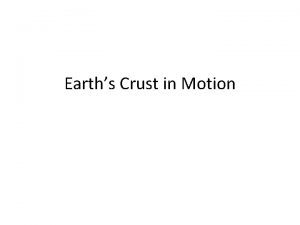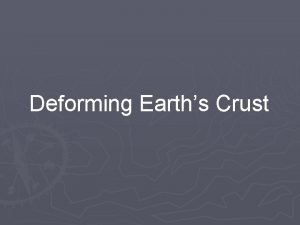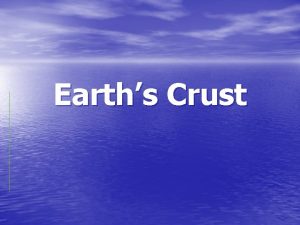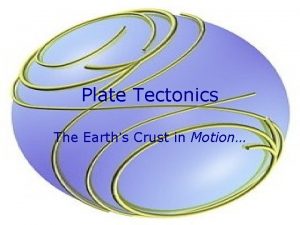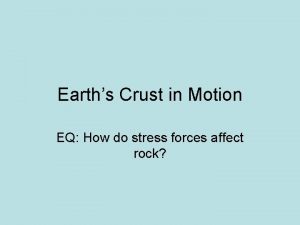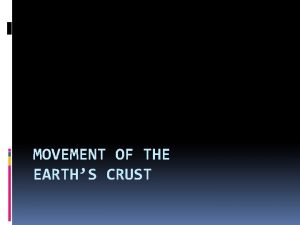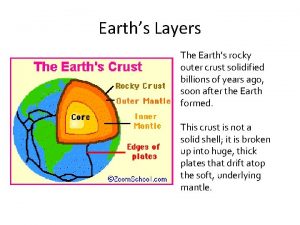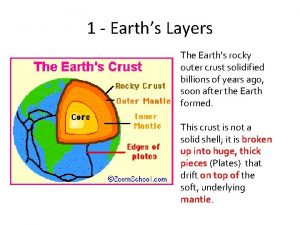Notes on Earths Crust in Motion Stress in













- Slides: 13

Notes on Earth’s Crust in Motion

Stress in the Crust Earthquake – the shaking and trembling that results from the movement of rock beneath Earth’s surface Stress – forces that act on rock to change its shape or volume Adds energy to rock Energy stored until the rock breaks or changes shape

Types of Stress Shearing, tension, and compression work over millions of years to change the shape and volume of rock Shearing – pushes a mass of rock in two different directions Tension – pulls on the crust, stretching the rock so it becomes thinner in the middle Compression Deformation – squeezes rock until it folds or breaks – a change in the volume or shape of Earth’s crust; happens very slowly

Types of Stress

Faults A little stress on a rock will bend and stretch it at first. When enough stress builds up in a rock, the rock breaks, creating a fault. Fault – a break in Earth’s crust where slabs of crust slip past each other. Faults usually occur along plate boundaries, where the forces of plate motion compress, pull, or shear the crust so much that the crust breaks.

Kinds of Faults Strike-slip faults – rocks on either side slip past each other sideways with little up or down motion. Created Ex. by shearing San Andreas fault in California

Kinds of Faults Normal faults – the fault is at an angle, so one block of rock lies above the fault (the hanging wall) and one below the fault (the footwall) Hanging wall slips downward. Created by tension forces where plates diverge Ex. Rio Grande rift valley in NM

Kinds of Faults Reverse faults – same structure as a normal fault, but blocks move in the opposite direction Produced by compression forces Ex. Appalachian Mountains Ex. Glacier National Park

Friction Along Faults Friction is a force that opposes the motion of one surface as it moves across another When friction is low, the rocks slide by each other without much sticking When friction is higher, they jam together and jerk free, producing earthquakes

Mountain Building Over millions of years, fault movement can change a flat plain into a towering mountain range Mountains formed by Faulting – normal faults uplift a block of rock into a fault-block mountain

Mountain Building Mountains formed by folding Folds – bends in rock that form when compression shortens and thickens part of Earth’s crust May be caused by collisions of 2 plates Ex. Himalayas in Asia Ex. Alps in Europe

Mountain Building Anticlines – a fold in rock that bends upward into an arch Syncline – a fold in rock that bends downward to form a bowl Ex. Black Hills of South Dakota

Plateau A plateau is a large area of flat land elevated high above sea level
 Most abundant element in earth crust
Most abundant element in earth crust Basalt
Basalt The earth's layers foldable
The earth's layers foldable Earths crust
Earths crust True stress vs engineering stress
True stress vs engineering stress Axial stress definition
Axial stress definition Chapter 10 stress responses and stress management
Chapter 10 stress responses and stress management The earth's layers foldable
The earth's layers foldable Earths roation
Earths roation Whats earths moon called
Whats earths moon called Forest desert tundra grassland
Forest desert tundra grassland Whats earths moon called
Whats earths moon called Thickest layer of the earth
Thickest layer of the earth Earths early atmosphere contained
Earths early atmosphere contained














